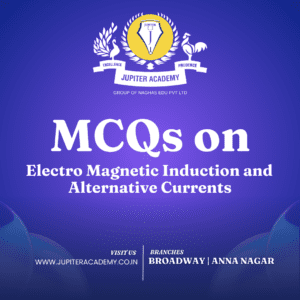TN Medical 2024 Counseling: Extension of Round 2 for MBBS...
Read More

Electromagnetic induction and alternative current NEET Exam mcqs
Electromagnetic induction and alternating current (AC) are two important topics in physics that are covered in the NEET exam.
Thank you for reading this post, don't forget to subscribe!- Electromagnetic induction is the production of an electromotive force (emf) across a conductor when the conductor is placed in a changing magnetic field. This principle is used in many devices, such as generators, transformers, and motors.
- Alternating current is a type of electric current that reverses its direction periodically. AC is used in most power transmission and distribution systems because it is more efficient than direct current (DC).
The NEET exam typically includes 1-2 questions on electromagnetic induction and 1-2 questions on AC. These questions can be conceptual or mathematical in nature.
Here are some of the reasons why it is important to study electromagnetic induction and AC for the NEET exam:
- These topics are essential for understanding the working of many electrical devices.
- Questions on these topics are often asked in the NEET exam.
- A good understanding of these topics can help you score better in the exam.
Electromagnetic induction and alternating current
Here are some NEET (National Eligibility cum Entrance Test) level multiple-choice questions on electromagnetic induction and alternating current:
**Electromagnetic Induction:**
**Question 1:**
Faraday’s law of electromagnetic induction states that:
a) Electric current produces a magnetic field
b) A magnetic field produces an electric field
c) A changing magnetic field induces an electric current
d) Electric and magnetic fields are independent of each other
**Answer 1:**
c) A changing magnetic field induces an electric current
**Question 2:**
Lenz’s law is a consequence of the law of conservation of:
a) Energy
b) Momentum
c) Charge
d) Angular momentum
**Answer 2:**
a) Energy
**Question 3:**
A coil of wire is placed in a magnetic field. If the number of magnetic field lines passing through the coil increases, the induced EMF will:
a) Increase
b) Decrease
c) Remain the same
d) Become zero
**Answer 3:**
a) Increase
**Question 4:**
The phenomenon of electromagnetic induction is used in the working principle of:
a) Generators
b) Transformers
c) Inductors
d) Capacitors
**Answer 4:**
a) Generators
**Question 5:**
A conductor of length L is moving with velocity v perpendicular to a magnetic field. The EMF induced across the ends of the conductor is:
a) BLv
b) Bv/L
c) B/Lv
d) BL/v
**Answer 5:**
b) Bv/L
**Alternating Current:**
**Question 6:**
In an AC circuit, the instantaneous current and voltage are given by:
a) I = I₀ sin(ωt), V = V₀ sin(ωt)
b) I = I₀ cos(ωt), V = V₀ cos(ωt)
c) I = I₀ sin(2ωt), V = V₀ sin(2ωt)
d) I = I₀ cos(2ωt), V = V₀ cos(2ωt)
**Answer 6:**
a) I = I₀ sin(ωt), V = V₀ sin(ωt)
**Question 7:**
The effective or root mean square (rms) value of AC current or voltage is:
a) Maximum value divided by π
b) Maximum value divided by √2
c) Maximum value multiplied by √2
d) Maximum value multiplied by π
**Answer 7:**
b) Maximum value divided by √2
**Question 8:**
The reactance of a capacitor in an AC circuit:
a) Decreases with frequency
b) Increases with frequency
c) Is independent of frequency
d) Becomes zero at resonance
**Answer 8:**
b) Increases with frequency
**Question 9:**
In an inductive AC circuit, the phase difference between current and voltage is:
a) 0°
b) 45°
c) 90°
d) 180°
**Answer 9:**
c) 90°
**Question 10:**
The power factor in an AC circuit is defined as the ratio of:
a) Apparent power to real power
b) Real power to apparent power
c) Apparent power to reactive power
d) Reactive power to apparent power
**Answer 10:**
b) Real power to apparent power
Feel free to ask for more questions or explanations on any of these topics!
Here are some JEE (Joint Entrance Examination) Main level multiple-choice questions on electromagnetic induction and alternating current:
**Electromagnetic Induction:**
**Question 1:**
When the magnetic flux linked with a closed loop changes, an emf is induced in the loop. This phenomenon is known as:
a) Ampere’s Law
b) Faraday’s Law of Electromagnetic Induction
c) Lenz’s Law
d) Gauss’s Law
**Answer 1:**
b) Faraday’s Law of Electromagnetic Induction
**Question 2:**
An emf is induced in a loop of wire when the magnetic field through it changes. Which of the following will not induce an emf?
a) Moving the loop through a magnetic field
b) Changing the orientation of the loop in a constant magnetic field
c) Changing the current passing through the loop
d) Changing the strength of the magnetic field
**Answer 2:**
c) Changing the current passing through the loop
**Question 3:**
A coil with 200 turns is placed in a magnetic field. If the magnetic flux through each turn is 0.02 Wb, the total flux linkage is:
a) 200 Wb
b) 4 Wb
c) 0.02 Wb
d) 40 Wb
**Answer 3:**
b) 4 Wb
**Question 4:**
The negative sign in Lenz’s law signifies that:
a) Induced emf is always negative
b) Induced current opposes the change in magnetic flux
c) Induced current is always negative
d) Induced emf is in the opposite direction of the magnetic field
**Answer 4:**
b) Induced current opposes the change in magnetic flux
**Question 5:**
A circular loop of wire is placed in a magnetic field perpendicular to the plane of the loop. If the magnetic field increases, the induced current in the loop will flow:
a) Clockwise
b) Counterclockwise
c) Along the diameter
d) There will be no induced current
**Answer 5:**
a) Clockwise
**Alternating Current:**
**Question 6:**
In an AC circuit, the instantaneous current is given by I(t) = I₀ sin(ωt), where I₀ is the maximum current amplitude and ω is the angular frequency. The time taken for the current to go from zero to its maximum value is:
a) π/2 ω
b) π ω
c) 2π/ω
d) π/ω
**Answer 6:**
a) π/2 ω
**Question 7:**
In an AC circuit, the power dissipation is given by P(t) = P₀ sin²(ωt), where P₀ is the maximum power. The average power over a complete cycle is:
a) 0
b) P₀
c) P₀/2
d) P₀/π
**Answer 7:**
c) P₀/2
**Question 8:**
The reactance of a capacitor in an AC circuit:
a) Increases with frequency
b) Decreases with frequency
c) Remains constant with frequency
d) Is not affected by frequency
**Answer 8:**
a) Increases with frequency
**Question 9:**
In an AC circuit containing only a resistor and an inductor in series, the phase difference between the current and the voltage is:
a) 0°
b) 45°
c) 90°
d) 180°
**Answer 9:**
c) 90°
**Question 10:**
In an ideal inductor, the phase difference between the current and the voltage is:
a) 0°
b) 45°
c) 90°
d) 180°
**Answer 10:**
c) 90°
TENTATIVE ROUND-II COUNSELLING SCHEDULE FOR ADMISSION TO MBBS/BDS
Registration Starts from 11-09-2024 10:00 A.M to 13-09-2024 05:00 P.M....
Read MoreNEET UG 2024 – MCC Extends Choice Submission Date
Now Candidates Can Do Choice Filling Till 11 September Thank...
Read MoreTN MEDICAL PROVISIONAL RESULTS ROUND-1- UG MEDICAL AND DENTAL – RELEASED
TN MEDICAL PROVISIONAL RESULTS ROUND-1- UG MEDICAL AND DENTAL ADMISSION...
Read Moreelectromagnetic induction and alternative current NEET Exam mcqs electromagnetic induction and alternative current NEET Exam mcqs electromagnetic induction and alternative current NEET Exam mcqs electromagnetic induction and alternative current NEET Exam mcqs electromagnetic induction and alternative current NEET Exam mcqs electromagnetic induction and alternative current NEET Exam mcqs electromagnetic induction and alternative current NEET Exam mcqs electromagnetic induction and alternative current NEET Exam mcqs electromagnetic induction and alternative current NEET Exam mcqs electromagnetic induction and alternative current NEET Exam mcqs






